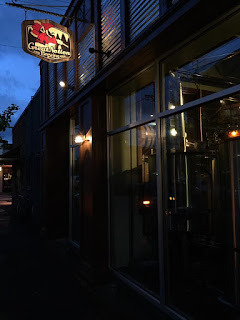We have a very special episode of the Beervana Podcast for you this week, and I want to tease it by quoting from a section of the interview. Patrick and I visited the labs and brewery of Tom Shellhammer, who is a professor of fermentation science at Oregon State University and one of the world's leading hops researchers. Before we did the interview, he took us around his labs, stopping at one point in front of stacks of small bottles containing aroma compounds found in hops. He uses these in classwork as a way of giving students a pure, condensed version of these aromas. We took a whiff of the "stone fruit" and "catty" bottles.
As we spoke about the catty scent, Tom referenced a class of compounds that have started to get more attention--thiols. These are sulfur-containing aroma compounds in hop oil that are responsible for both the deeply tropical aromas in many recent hop varieties, but also aromas some of us find objectionable (sweat, onion, garlic). Here's Tom, in a quick-and-dirty transcript from the podcast:
Thiols are a class of chemical compounds that have sulfur in them. So that sulfur part is what makes the compound a thiol. Not that all sulfur compounds are thiols, but a thiol has sulfur in it; that's the key component to that. Myrcene and linalool don't have sulfur in them. Myrcene is a hydrocarbon. [Describes the chemical structure.] Linalool is an oxygenated version of that, so it's got an oxygen component in it that does things to its functionality and its solubility. Hydrocarbons as a class tend to be more woodsy, herbal, and somewhat floral. They oxygenated versions of these things like linalool and geraniol tend to be floral and fruity. And then we move to this thiol class.One of the reasons some people absolutely love hops like Summit and Nelson Sauvin is because they're getting the fruit. But I am apparently hyper-sensitive to thiols, and I get the onion and sweat.
The hydrocarbons make up to 75 to 90% of the hop oil, the oxygenated fraction makes up almost the rest, and then less than 1% are these sulfur compounds. Tiny, tiny amount. But the thing about them that make them so important is the aroma-detection thresholds of these things are three to four, maybe five, orders of magnitude lower than these other compounds. With myrcene, you need about 300-500 parts per billion. Sounds like a small amount, but not quite a part per million. And the thiols, their aroma thresholds are parts per trillion. A little goes a long way with a thiol.
The thiol compounds can be stinky like onions and garlic but they can also be potent tropical fruity, citrusy, but also animal-y, stinky, sweaty/BO.
This podcast, I'm pleased to say, is filled with gems like this. (It's part one of our visit down there. Next week we go to the test brewery at OSU and join the head brewer there, Jeff Clawson. Hop talk continues as we sample beer students made in the brewery.) Definitely give it a listen:
Finally, if this all seems irresistible to you (and how can it not??), Tom and Jeff Clawson are leading a two-day course in Portland for those of you who'd like access to some of the content he presents in his coursework, but who don't have the time or money to take a class in Corvallis.
Our Origins of Beer Flavors and Styles workshop is an experiential sensory course that will guide you through the brewing process from raw materials to finished beer. Through hands-on instruction, participants will learn how the main raw materials used in brewing process (malt, water, hops, and yeast) impact beer flavor and aroma. Participants will work through standards and exercises with the goal of highlighting how each of these materials impacts beer flavor. Guiding tastings, focused with a historical lens, will also walk participants through on how these raw materials have impacted beer styles historically overtime. Over this two-day course, participants will evaluate 8 beer styles and over 35 beers.If memory serves, a part of the class will involve those little glass vials of hop aromas. Soon you, too, will be able to distinguish thiols, hydrocarbons, and oxygenated hydrocarbons from one another. Follow this link to register.
Friday, March 17 - Saturday, March 18, 2017












